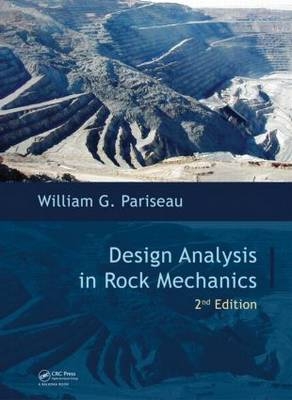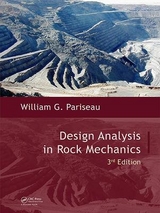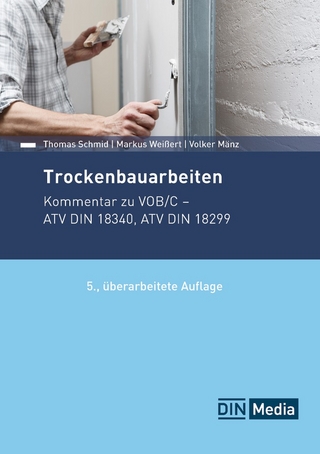
Design Analysis in Rock Mechanics, Second Edition
Taylor & Francis Ltd (Verlag)
978-0-415-89339-8 (ISBN)
- Titel erscheint in neuer Auflage
- Artikel merken
Developed for a complete class in rock engineering, Design Analysis in Rock Mechanics, Second Edition uniquely combines the design of surface and underground rock excavations and addresses:
Rock slope stability in surface excavations, from planar block and wedge slides to rotational and toppling failures
Shaft and tunnel stability, ranging from naturally supported openings to analysis and design of artificial support and reinforcement systems
Entries and pillars in stratified ground
Three-dimensional caverns, with an emphasis on cable bolting and backfill
Geometry and forces of chimney caving, combination support, and trough subsidence
Rock bursts and bumps in underground excavations, with a focus on dynamic phenomena and on fast and sometimes catastrophic failures
The numerous exercises and examples familiarize the reader with solving basic practical problems in rock mechanics through various design analysis techniques and their applications. Supporting the main text, appendices provide supplementary information about rock, joint, and composite properties, rock mass classification schemes, useful formulas, and an extensive literature list. The large selection of problems at the end of each chapter can be used for homework assignments.
Explanatory and illustrative in character, this volume is suited for courses in rock mechanics, rock engineering and geological engineering design for undergraduate and first-year graduate students in mining, civil engineering, and applied earth sciences. Moreover, it will form a good introduction to the subject of rock mechanics for earth scientists and engineers from other disciplines.
W.G. Pariseau studied Mining Engineering at the University of Washington, Seattle and obtained his Ph.D. Degree from the University of Minnesota. Throughout his career, he gathered many years of experience in teaching, research and in consulting for government agencies and mining companies. He received several prestigious awards for his outstanding work and teaching skills. He recently achieved emeritus status as the Malcolm McKinnon Professor (endowed chair) in the Department of Mining Engineering at the University of Utah and maintains an active presence in several professional societies and editorial boards.
Preface
Acknowledgments
1 Introduction
1.1 A practical design objective
1.2 Problem solving
1.3 Units
1.4 Background information
- Rock mechanics literature
- Mechanical properties of rock
1.5 Problems
- Basics
- Review of stress
- Review of strain and elasticity
- Additional Problems
2 Slope stability
2.1 Translational rock slope failures
- Planar block slides
- Safety factor improvement
- Wedge failures
2.2 Rotational slope failures
- Remedial measures
- Base failures
- Toppling failures
2.3 Problems
- Planar block slides
- Wedge failures
- Rotational slides
- Dynamics, toppling
- Additional Problems
3 Shafts
3.1 Single unlined naturally supported shafts
- Shaft wall stress concentration
- Unlined circular shafts
- Unlined elliptical shafts
- Unlined rectangular shafts
- Shaft wall strengths
3.2 Shaft wall support and liners
- Shaft wall bolting
- Circular shaft liners
- Circular steel rings
3.3 Multiple naturally supported shafts
- Circular shafts in a row
- Shaft pillar safety
- Two circular shafts of different diameter
- Elliptical shafts in a row
- Rectangular shafts in a row
3.4 Problems
- Single, naturally supported shafts
- Supported shafts, liners, bolts, rings
- Multiple shafts
- Additional Problems
4 Tunnels
4.1 Naturally supported tunnels
- Single tunnels
- Single tunnel joints
- Multiple tunnels
4.2 Tunnel support
- Fixed steel sets
- Pattern bolting – rock reinforcement
- Combination support
- Yieldable steel arches
- Light segment liner
4.3 Problems
- Naturally supported tunnels
- Supported tunnels
- Rock mass classification schemes, RQD
- Additional Problems
5 Entries in stratified ground
5.1 Review of beam analysis
- Basic beam formulas
- Important special cases
5.2 Softrock entries
- Naturally supported roof
- Bolted roof
- Point anchored roof bolting
- Distributed anchorage roof bolting
- Roof trusses
- Additional Examples
5.3 Problems
- Naturally supported roof
- Bolted roof
- Additional Problems
6 Pillars in stratified ground
6.1 Pillars in a single seam
- Tributary area, extraction ratio analysis
- Size effect on strength
6.2 Pillars in dipping strata
- Extraction ratio formulas for pillars in dipping seams
- An unconventional Mohr’s circle representation
- Generalized Mohr’s circle
- Backfill effects on pillar safety factors
6.3 Pillars with joints
- Flat seam pillars with joints
- Dipping seam pillars with joints
6.4 Pillars in several seams
- Columnized main entry pillars
- Staggered chain entry pillars
6.5 Barrier pillars
6.6 Problems
7 Three-dimensional excavations
7.1 Naturally supported caverns and stopes
- Spheroidal excavations
- Cubical and brick-shaped excavations
7.2 Joints in cavern and stope walls
7.3 Tabular excavations
7.4 Cavern and stope support
- Hardrock mine fill
- Cable bolts support
- Additional Examples
7.5 Problems
- 3D Caverns
- Back fill
- Cable bolting
- Additional Problems
8 Subsidence
8.1 Chimneys
- Chimney cave geometry
- Caving rock flow
- Chimney cave forces
- Chimney cave water forces
- Support near caving ground
8.2 Troughs
- Limit of subsidence
- Maximum subsidence
- Critical width
- NCB subsidence profile
- Angle of draw and subsidence factor adjustments
- NCB strain profile
- Surface damage
- Multipanel, multiseam subsidence
- Alternative approaches to subsidence
8.3 Problems
- Chimney caving
- Combination support
- Subsidence troughs
- Profile and influence functions
9 Dynamic Phenomena
9.1 Fundamentals of wave propagation
- Simple wave propagation models
- Reflection at free and fixed faces under normal incidence
- Reflection and transmission at an interface under normal incidence
- Reflection and transmission at an interface under oblique incidence
9.2 Rock bursts and bumps
- Face bursts and bumps
- Pillar bursts and bumps
- Fault Slip
9.3 Event location
9.4 Problems
Appendix A: Background literature
A.1 Books about fundamentals of mechanics
A.2 Books about rock mechanics
A.3 Books containing rock properties
A.4 General sources of rock mechanics information
Appendix B: Mechanical properties of intact rock and joints
B.1 Elastic moduli of intact rock
- Young’s modulus
- Poisson’s ratio
- Shear modulus
- Anisotropy
B.2 Strength of intact rock
- Tensile strength
- Unconfined compressive strength
- Compressive strength under confining pressure
- Mohr–Coulomb strength
- Hoek–Brown strength
- Drucker–Prager strength
- Nonlinear n-type strength
- Compressive strength test data
B.3 Joint stiffness
- Normal stiffness
- Shear stiffness
B.4 Joint strength
B.5 Simple combinations of intact rock and joints
- Continuously jointed rock mass moduli
- Discontinuously jointed rock mass moduli
- Continuously jointed rock mass strengths
- Discontinuously jointed rock mass strengths
Appendix C: Rock mass classification schemes for engineering
C.1 Rock quality designation
C.2 Terzaghi modified scheme
C.3 RSR, RMR, and Q
C.4 Comparisons of Hp estimates
C.5 GSI
C.6 Comment
Appendix D: Some useful formulas
D.1 Stress
- Normal and shear stress on a plane
- Principal (normal) stresses
- Principal shear stresses
- Mohr’s circle
D.2 Strain
- Strain rosettes
- Small strain–displacement relations
D.3 Stress–strain relationships, Hooke’s law
- Hooke’s law in one dimension – Young’s modulus and shear modulus
- Hooke’s law in two-dimensions – plane stress and plane strain
References
Index
| Zusatzinfo | 163 Line drawings, black and white; 163 Illustrations, black and white |
|---|---|
| Verlagsort | London |
| Sprache | englisch |
| Maße | 174 x 246 mm |
| Gewicht | 1338 g |
| Themenwelt | Technik ► Bauwesen |
| Technik ► Bergbau | |
| ISBN-10 | 0-415-89339-9 / 0415893399 |
| ISBN-13 | 978-0-415-89339-8 / 9780415893398 |
| Zustand | Neuware |
| Informationen gemäß Produktsicherheitsverordnung (GPSR) | |
| Haben Sie eine Frage zum Produkt? |
aus dem Bereich



